Posted by · Leave a Comment
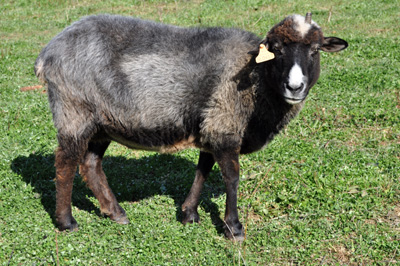 This is Reese, the matriarch of our flock. I took this picture because she was looking “fluffy.” Mind you, it’s not a word I use often when describing my sheep, but it seemed as though her coat had changed, almost overnight. She was sheared six weeks before so she already has over an inch of coat growth.
This is Reese, the matriarch of our flock. I took this picture because she was looking “fluffy.” Mind you, it’s not a word I use often when describing my sheep, but it seemed as though her coat had changed, almost overnight. She was sheared six weeks before so she already has over an inch of coat growth.
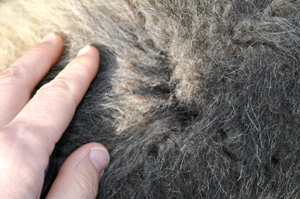
Inner Coat - Wool
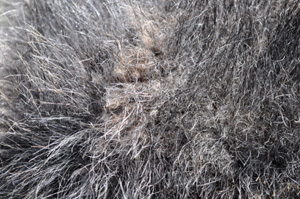
Outer Coat - Hair
The Navajo-Churro fleece consists of both wool and hair. The inner coat of wool is the closest growth to the skin and is a separate layer from the “hair”, which are the longer locks you see draping the sheep later in the season. The inner coat can grow to three to six inches and represents roughly 80 percent of the fleece. The hair, or outer coat, comprises 10 to 20 percent of the fleece and can have a staple length of six to 12 inches.
Reese is my girl (remember in the blog post about the pasture gate—she “called out” that it was open)!! She’ll always walk to me to get a back scratch or shoulder rub but doesn’t like the camera. So for me to be able to snap a quick photo of her fleece was a pretty special occurrence. It’s easiest to see the wool-hair variation on her because of her coloring and markings.
She’s definitely pregnant, too—I can tell—so I’ll make time for lots of back-scratches and shoulder rubs in these coming months.

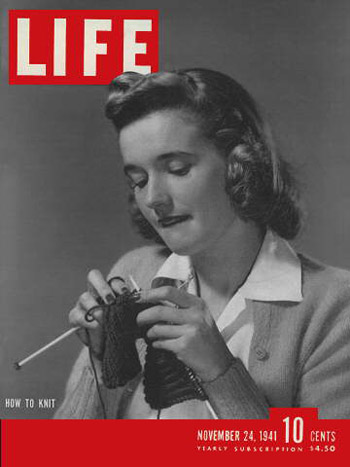 It’s November, 1941.
It’s November, 1941.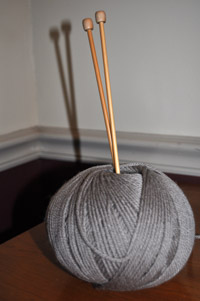 So, you see, knitting, most definitely, has a special place in our history. Whether you knit for fun or for “a purpose,” it’s a skill well worth pursuing.
So, you see, knitting, most definitely, has a special place in our history. Whether you knit for fun or for “a purpose,” it’s a skill well worth pursuing.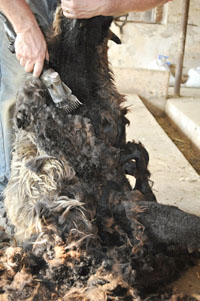 Navajo-Churro sheep need to be shorn twice a year. Their wool grows an inch a month.
Navajo-Churro sheep need to be shorn twice a year. Their wool grows an inch a month.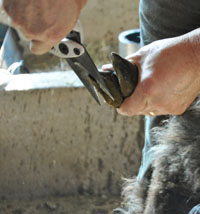 He’ll trim the hooves, de-worm (if we wish) – which just means he administers a “drench,” that is a liquid – and shear.
He’ll trim the hooves, de-worm (if we wish) – which just means he administers a “drench,” that is a liquid – and shear.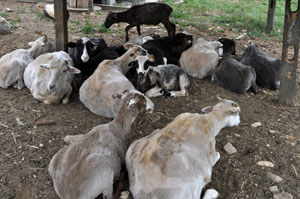 Sheep almost look like different animals after a shearing. It just has to feel good to have that “haircut” every six months or so – just look at how relaxed they all looked that next morning.
Sheep almost look like different animals after a shearing. It just has to feel good to have that “haircut” every six months or so – just look at how relaxed they all looked that next morning. “Ottawa”, the stunning white ram-lamb went home with Shelly to New York and handsome little “Newman” made the trek back to Linda’s Shepherd’s Loft in Pennsylvania.
“Ottawa”, the stunning white ram-lamb went home with Shelly to New York and handsome little “Newman” made the trek back to Linda’s Shepherd’s Loft in Pennsylvania.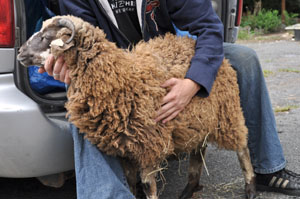
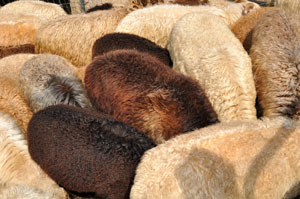 The Navajo-Churro wool is beautiful! Just look at the colors of the sheep I was able to photograph before everyone came charging into the barn last week. I’ve been fascinated by their coats since we first purchased Reese and her twins, Lovey and Clara (Clara Barton Angel Of The Battlefield, so named by my history-loving son) years ago.
The Navajo-Churro wool is beautiful! Just look at the colors of the sheep I was able to photograph before everyone came charging into the barn last week. I’ve been fascinated by their coats since we first purchased Reese and her twins, Lovey and Clara (Clara Barton Angel Of The Battlefield, so named by my history-loving son) years ago.
